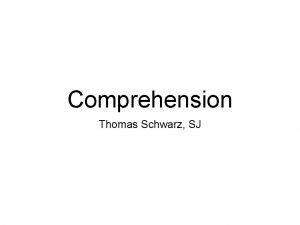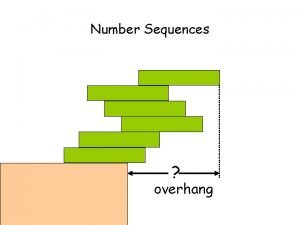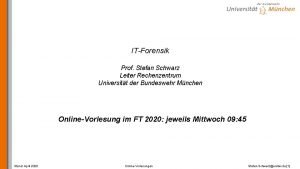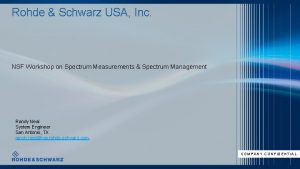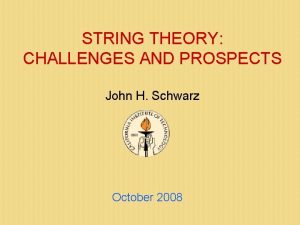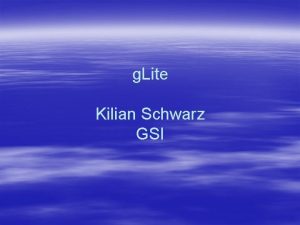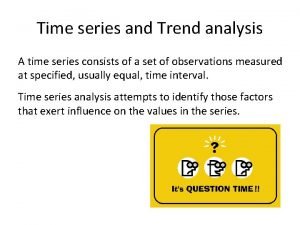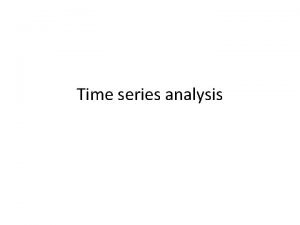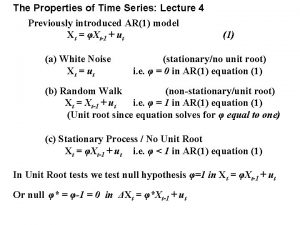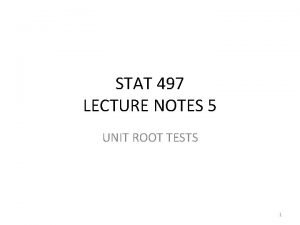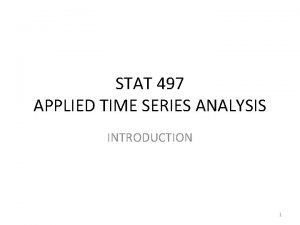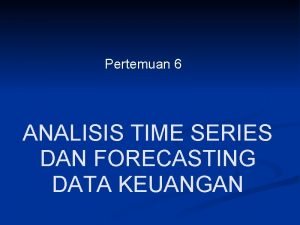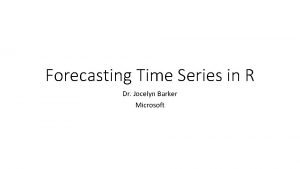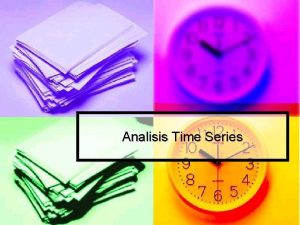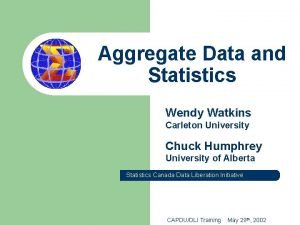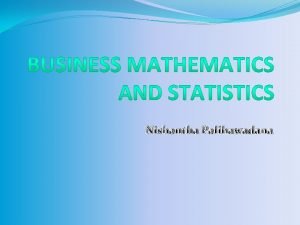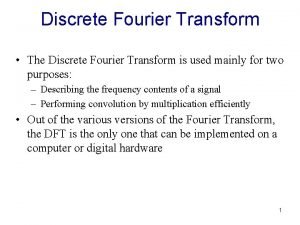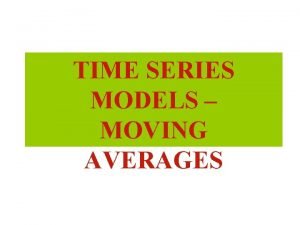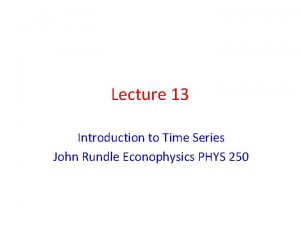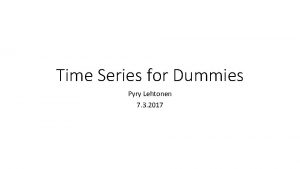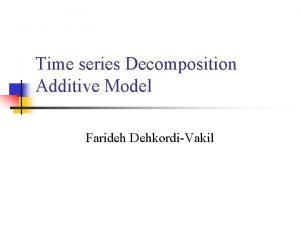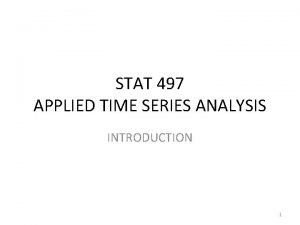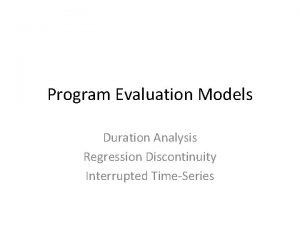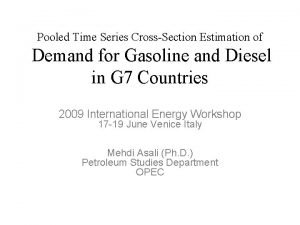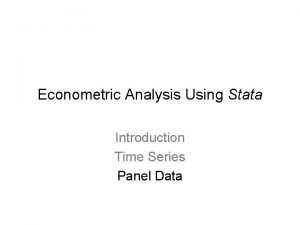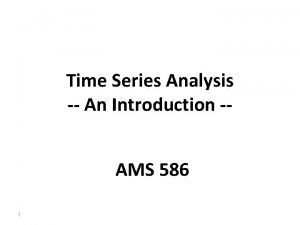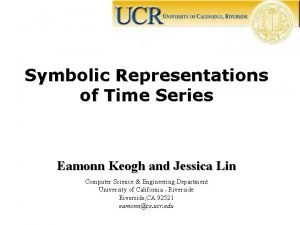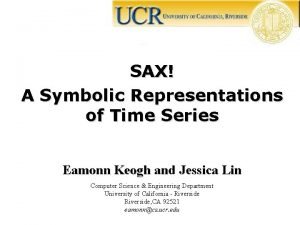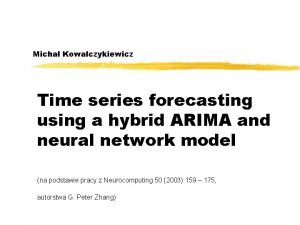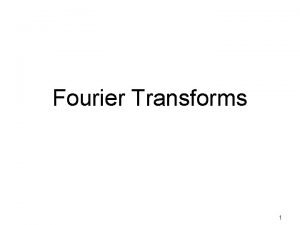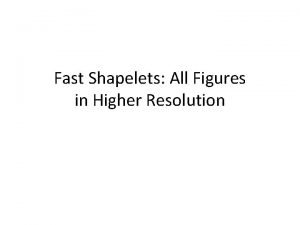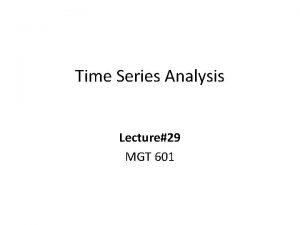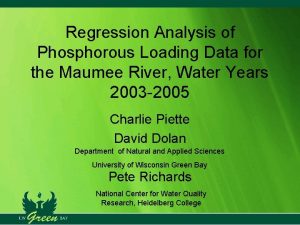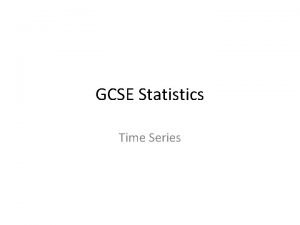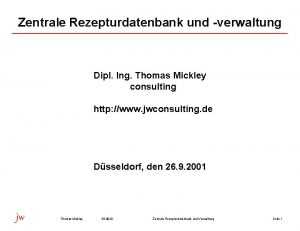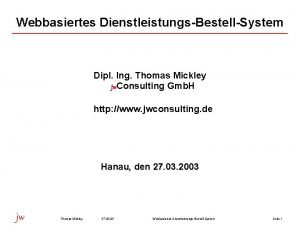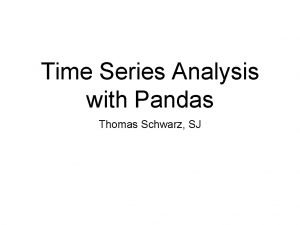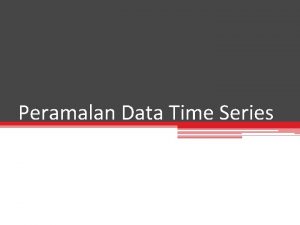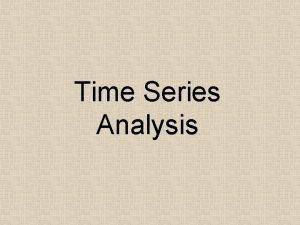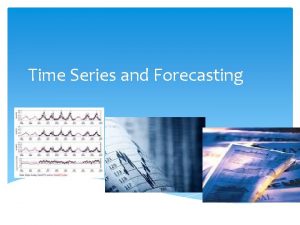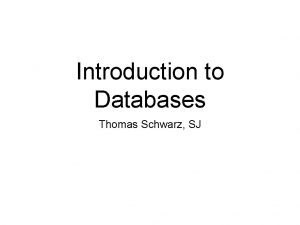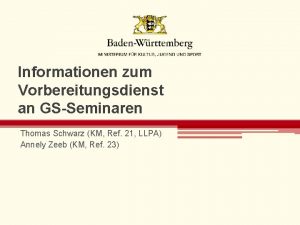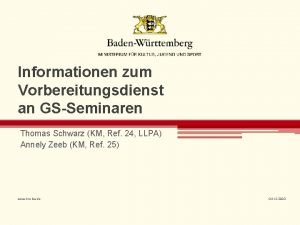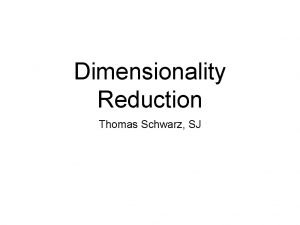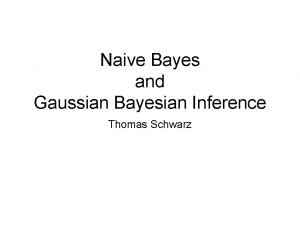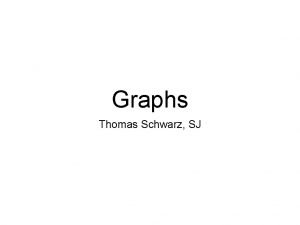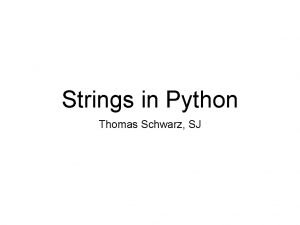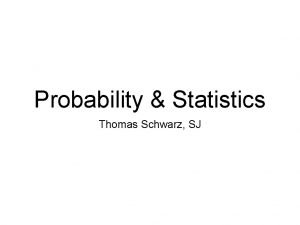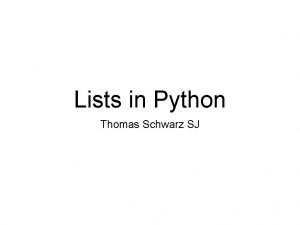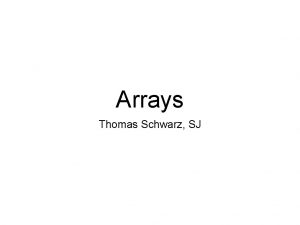Time Series 2 Thomas Schwarz SJ Time Series


























![Seasonal Dummy Variables • Add a new column for the prediction • • df_ab['pred'] Seasonal Dummy Variables • Add a new column for the prediction • • df_ab['pred']](https://slidetodoc.com/presentation_image_h/1bfb7b2f10aeeb4b14d4dc8b6d89a7b6/image-27.jpg)

















![Better Decompositions • Example: Australian Beer: df = get_data()['1975 Q 1': ] stl = Better Decompositions • Example: Australian Beer: df = get_data()['1975 Q 1': ] stl =](https://slidetodoc.com/presentation_image_h/1bfb7b2f10aeeb4b14d4dc8b6d89a7b6/image-45.jpg)




























- Slides: 73

Time Series 2 Thomas Schwarz SJ

Time Series • General Model of a time series: • • • Trend + seasonal(s) + remainder Trend seasonal(s) remainders Remainder can be modeled as a random walk

Trends • Example: Disposable Personal Income Massachusetts and Missouri • • from Federal Reserve Bank of St. Louis Need to check the raw data: Use separator df_ma = pd. read_csv('MAPCPI. csv', sep = ', ', ) df_ma. set_index('DATE', inplace = True)

Trends • Example continued: • We have two different files that we want to combine • Pandas has a merge function • Which needs to have a common column • Actually, merge implements an SQL-like join df = pd. merge(df_ma, df_mo, on='DATE')

Trends • We can now use linear recursion from statsmodels. formula. api import ols … model = ols("df. MOPCPI ~ df. MAPCPI", df). fit() inter, coef = model. params print(inter, coef) print(model. summary()) 900. 173966439816 0. 6894112036215065

Trends OLS Regression Results ======================================= Dep. Variable: df. MOPCPI R-squared: 0. 995 Model: OLS Adj. R-squared: 0. 995 Method: Least Squares F-statistic: 1. 710 e+04 Date: Fri, 03 Jul 2020 Prob (F-statistic): 1. 60 e-103 Time: 16: 40: 01 Log-Likelihood: -762. 99 No. Observations: 91 AIC: 1530. Df Residuals: 89 BIC: 1535. Df Model: 1 Covariance Type: nonrobust ======================================= coef std err t P>|t| [0. 025 0. 975] ---------------------------------------Intercept 900. 1740 147. 748 6. 093 0. 000 606. 601 1193. 747 df. MAPCPI 0. 6894 0. 005 130. 771 0. 000 0. 679 0. 700 ======================================= Omnibus: 0. 064 Durbin-Watson: 0. 066 Prob(Omnibus): 0. 969 Jarque-Bera (JB): 0. 069 Skew: 0. 051 Prob(JB): 0. 966 Kurtosis: 2. 911 Cond. No. 3. 69 e+04 =======================================

Trends • We then plot the result: plt. plot(df. MAPCPI, df. MOPCPI, '. ', alpha=0. 3) plt. plot(np. linspace(0, 75000), inter + coef*np. linsp plt. xlabel('MA') plt. ylabel('MO') plt. show()

Trends

Trends • We now look at the residual • We define it as an additional column df['residual'] = df. MOPCPI - inter-coef*df. MAPCPI

Trends • Showing the residual: • • Use xticks to make the x-axis readable And use fill to make the result clearer plt. plot(df. residual, 'k-') plt. xticks(['1930 -01 -01', '1950 -01 -01', '1970 -01 -01', ' plt. fill_between(df. index, 0, df. residual) plt. show()

Trends

Trends • This would be a bad regression for prediction!

Seasonal Dummy Variables • • Suppose you want to use linear regression Need to account for the effect of week-days • Introduce dummy variables t 1 t 2 t 3 t 4 t 5 t 6 t 7 3 Mon 1 0 0 0 Tue 0 1 0 0 0 Wed 0 0 1 0 0 Thu 0 0 0 1 0 0 0 Fri 0 0 1 0 0 Sat 0 0 0 1 0 Sun 0 0 0 1

Seasonal Dummy Variables • Use linear regression including the dummy variables

Seasonal Dummy Variables • Example: • Australian beer production (quarterly)

Seasonal Dummy Variables • Obviously, two different trends, 1955 - 1975 and 1975 -

Seasonal Dummy Variables • def Look at the original data: Time, Year, Quarter, Beer. Production 1, 1956, Q 1, 284 2, 1956, Q 2, 213 3, 1956, Q 3, 227 4, 1956, Q 4, 308 5, 1957, Q 1, 262 6, 1957, Q 2, 228 7, 1957, Q 3, 236 8, 1957, Q 4, 320 9, 1958, Q 1, 272 10, 1958, Q 2, 233 11, 1958, Q 3, 237 get_data(): 12, 1958, Q 4, 313 df_ab = pd. read_csv('Aus. Beer. csv', 13, 1959, Q 1, 261 14, 1959, Q 2, 227 sep = ', ', 15, 1959, Q 3, 250 parse_dates={'period': ['Year', 'Quarter']} 16, 1959, Q 4, 314 ) 17, 1960, Q 1, 286 • Need to parse time stamps from two different columns • Luckily, parse data is up to it df_ab = df_ab. set_index('period') return df_ab

Seasonal Dummy Variables • Aside: • When we draw the graph, need to select x-ticks def show(df_ab): plt. plot(df_ab['Beer. Production']) plt. plot(df_ab['pred']) plt. xticks(['1960 Q 1', '1980 Q 1', '2000 Q 1']) plt. show()

Seasonal Dummy Variables • First, linear regression just on beer production • without accounting for the influence of the quarters df_ab = get_data() df = df_ab. loc['1979 Q 1': ] y = df['Beer. Production'] x = df['Time'] model = ols("y~ x", df). fit() print(model. summary())

Seasonal Dummy Variables • This gives so-so values (as should be expected) OLS Regression Results ======================================= Dep. Variable: y R-squared: 0. 169 Model: OLS Adj. R-squared: 0. 163 Method: Least Squares F-statistic: 25. 26 Date: Fri, 03 Jul 2020 Prob (F-statistic): 1. 71 e-06 Time: 23: 43: 30 Log-Likelihood: -667. 55 No. Observations: 126 AIC: 1339. Df Residuals: 124 BIC: 1345. Df Model: 1 Covariance Type: nonrobust ======================================= coef std err t P>|t| [0. 025 0. 975] ---------------------------------------Intercept 545. 7075 19. 076 28. 606 0. 000 507. 950 583. 465 x -0. 6003 0. 119 -5. 026 0. 000 -0. 837 -0. 364 ======================================= Omnibus: 13. 659 Durbin-Watson: 2. 182 Prob(Omnibus): 0. 001 Jarque-Bera (JB): 15. 806 Skew: 0. 858 Prob(JB): 0. 000370 Kurtosis: 2. 740 Cond. No. 701. =======================================

Seasonal Dummy Variables • But already some nice trend • • Get the model parameters and add a new column with predicted values a, b = model. params df_ab['pred'] = a + b*df. Time Then display df_ab. dropna(inplace=True) plt. plot(df_ab['Beer. Production']) plt. plot(df_ab['pred']) plt. xticks(['1980 Q 1', '1985 Q 1', '1990 Q 1', '1995 Q 1', '2000 Q 1', '2005 Q 1', '2010 Q 1'], ['80', '85', '90', '95', '00', '05', '10'])

Seasonal Dummy Variables

Seasonal Dummy Variables • Now, let's try using seasonal dummy variables • Create four new columns def transform(df_ab): df_ab['s 1'] = [ 1 else 0 for df_ab['s 2'] = [ 1 else 0 for df_ab['s 3'] = [ 1 else 0 for df_ab['s 4'] = [ 1 else 0 for if 'Q 1' in df_ab. index[i] i in range(len(df_ab. index))] if 'Q 2' in df_ab. index[i] i in range(len(df_ab. index))] if 'Q 3' in df_ab. index[i] i in range(len(df_ab. index))] if 'Q 4' in df_ab. index[i] i in range(len(df_ab. index))]

Seasonal Dummy Variables • Create a slice since 1979 df_ab = get_data() transform(df_ab) df = df_ab. loc['1979 Q 1': ]

Seasonal Dummy Variables • Set up the model including the seasonal parameters y = df['Beer. Production'] x = df['Time'] x 1 = df['s 1'] x 2 = df['s 2'] x 3 = df['s 3'] x 4 = df['s 4'] model = ols("y~ x", df). fit() print(model. summary()) a, b, b 1, b 2, b 3, b 4 = model. params print(a, b, b 1, b 2, b 3, b 4)

Seasonal Dummy Variables OLS Regression Results ======================================= Dep. Variable: y R-squared: 0. 887 Model: OLS Adj. R-squared: 0. 883 Method: Least Squares F-statistic: 237. 6 Date: Fri, 03 Jul 2020 Prob (F-statistic): 2. 70 e-56 Time: 23: 56: 27 Log-Likelihood: -541. 83 No. Observations: 126 AIC: 1094. Df Residuals: 121 BIC: 1108. Df Model: 4 Covariance Type: nonrobust ======================================= coef std err t P>|t| [0. 025 0. 975] ---------------------------------------Intercept 437. 5337 5. 696 76. 809 0. 000 426. 256 448. 811 x -0. 6058 0. 045 -13. 586 0. 000 -0. 694 -0. 517 x 1 107. 4220 3. 124 34. 390 0. 000 101. 238 113. 606 x 2 65. 4965 3. 143 20. 837 0. 000 59. 273 71. 720 x 3 81. 4240 3. 156 25. 804 0. 000 75. 177 87. 671 x 4 183. 1911 3. 175 57. 697 0. 000 176. 905 189. 477 ======================================= Omnibus: 20. 235 Durbin-Watson: 1. 948 Prob(Omnibus): 0. 000 Jarque-Bera (JB): 34. 949 Skew: 0. 731 Prob(JB): 2. 58 e-08 Kurtosis: 5. 126 Cond. No. 4. 40 e+17 =======================================
![Seasonal Dummy Variables Add a new column for the prediction dfabpred Seasonal Dummy Variables • Add a new column for the prediction • • df_ab['pred']](https://slidetodoc.com/presentation_image_h/1bfb7b2f10aeeb4b14d4dc8b6d89a7b6/image-27.jpg)
Seasonal Dummy Variables • Add a new column for the prediction • • df_ab['pred'] = a + b*df. Time +b 1*df. s 1+b 2*df. s 2 df_ab. dropna(inplace=True) And plot raw data and prediction values plt. plot(df_ab['Beer. Production']) plt. plot(df_ab['pred'], alpha = 0. 5) plt. xticks(['1980 Q 1', '1985 Q 1', '1990 Q 1', '1995 Q 1', '2000 Q 1', '2005 Q 1', '2010 Q 1'], ['80', '85', '90', '95', '00', '05', '10']) plt. show()

Seasonal Dummy Variables

Seasonal Dummy Variables • Why are we not doing better? • We only have time and season as explanatory variables • Temperature and economy could also explain beer consumption • And maybe exports?

Seasonal Dummy Variables • Let's look at the average error of the prediction • Add one more column to the data frame • • df_ab['res'] = (df_ab['Beer. Production']df_ab['pred'])/df_ab['Beer. Production'] And display

Seasonal Dummy Variables • Shows that we are historically with 10% of the linear regression calculated value

Seasonal Dummy Variables • We can also look at how well the prediction works plt. scatter(df_ab['Beer. Production'][df_ab['s 1']==1], df_ab['pred'][df_ab['s 1']==1], alpha = 0. 5, c = 'red', label='Q 1') plt. scatter(df_ab['Beer. Production'][df_ab['s 2']==1], df_ab['pred'][df_ab['s 2']==1], alpha = 0. 5, c = 'green', label='Q 2') plt. scatter(df_ab['Beer. Production'][df_ab['s 3']==1], df_ab['pred'][df_ab['s 3']==1], alpha = 0. 5, c = 'blue', label='Q 3') plt. scatter(df_ab['Beer. Production'][df_ab['s 4']==1], df_ab['pred'][df_ab['s 4']==1], alpha = 0. 5, c = 'cyan', label='Q 4') plt. legend() plt. show()

Seasonal Dummy Variables

Classical Decomposition • Simple method with periods of m on • • quarters: m=4, business weeks: m=5, years: m = 365 Additive decomposition: • • • Use moving average of size 2 m (or m) to estimate • Residual is what is left Calculate the "detrended" series Seasonal component is the average over all values for that period

Classical Decomposition • Problems with classical decomposition: • Trend cycle not available for the first or last times without extrapolation • • Rapid rises and falls are smoothed out too much Assumes seasonal components repeat • • Counter-example: • Used to be that electricity consumption peaked in the winter (heating) • Now peaks in the summer (air-conditioning) Really difficult to deal with extra-ordinary events (strikes, weather, catastrophes, …)

Classical Decomposition • Implemented in statsmodels from statsmodels. tsa. seasonal import seasonal_decompose • • • Needs a time series x Needs a model: "additive" (default), "multiplicative Can give filtering weights Period (if x not Pandas with frequency) two-sided: method used for filtering extrapolate_trend: non-zero value or 'freq' to extrapolate • Otherwise, Na. N values

Classical Decomposition • Example: Australian beer production (again) def get_data(): df_ab = pd. read_csv('Aus. Beer. csv', sep = ', ', parse_dates={'period': ['Year', 'Quarter']} ) df_ab = df_ab. set_index('period') return df_ab

Classical Decomposition • Limit to values after 1975 • • df = get_data()['1975 Q 1': ] Call decomposition • • result = seasonal_decompose( df['Beer. Production'], model = 'additive', period = 4, extrapolate_trend = 3) result has components trend, seasonal, resid

Classical Decomposition • Show results: def show(result): fig, axs = plt. subplots(3, sharex=True, figsize=(5, 10)) axs[0]. plot(result. trend, 'k-') axs[1]. plot(result. seasonal, 'r: ') axs[2]. plot(result. resid, 'b-. ') axs[0]. set_title('trend') axs[1]. set_title('seasonal') axs[2]. set_title('residual') axs[2]. set_xticks(['1980 Q 1', '1990 Q 1', '2000 Q 1', '2010 Q 1']) axs[2]. set_xticklabels(['80', '90', '00', '10']) plt. show()

• • • Can extrapolate the trend Add seasonal Use residual as a measure of uncertainty

Classical Decomposition • airline passengers result = seasonal_decompose(df. Passengers, model = 'additive', period = 14, extrapolate_trend = 'freq' )


Better Decompositions • Decomposition has had a 100 year history • • Better decompositions allow seasonal values to vary Seasonal Decomposition using LOESS (STL) • LOESS is based on estimating the trend with a range of functions within a certain window

Better Decompositions • STL is implemented in statsmodels • • from statsmodels. tsa. seasonal import STL Uses the assumed cyclicity as input (periods)
![Better Decompositions Example Australian Beer df getdata1975 Q 1 stl Better Decompositions • Example: Australian Beer: df = get_data()['1975 Q 1': ] stl =](https://slidetodoc.com/presentation_image_h/1bfb7b2f10aeeb4b14d4dc8b6d89a7b6/image-45.jpg)
Better Decompositions • Example: Australian Beer: df = get_data()['1975 Q 1': ] stl = STL(df['Beer. Production'], period=4, robust=False) result = stl. fit() • Result is a triple of trend, seasonal, and resid

Better Decompositions robust not robust

Better Decompositions airline passengers not robust

Better Decompositions • Holt's linear trend method: • Simple exponential smoothing for data with trend • • Estimates series at time t using estimates of the slope obtained as a weighted average Holt-Winter's Seasonal Method • Adds a seasonal component

Better Decompositions • Implemented in statsmodels • • from statsmodels. tsa. holtwinters import Exponent Produces a fitted value (fit) and allows predictions df = get_data() esm = esm(df['Passengers'], seasonal='mul', seasonal_periods=12 ) result = esm. fit()

Better Decompositions • Airline Example (multiplicative fit)

Better Decompositions • Airline Example additive seasonality

Stationary Time Series • Properties do not depend on the time at which the series is observed • • No trend, no seasonality But could be cyclic if cycles have no fixed length

Stationary Time Series • Example: • Google High stock value is not stationary

Stationary Time Series • But it's daily change is

Stationary Time Series • Use shift in order to obtain the differences def get_google_data(): my_df = pd. read_csv('. . /Pandas/google. csv', parse_dates=[0], index_col=0, converters={ 'Close': my_converter, 'Volume': convert_volume} ) print(my_df. info()) #my_df. High. plot() (my_df. shift(1). High - my_df. High). plot() plt. show() return my_df

Stationary Time Series • This is typical • Differencing • • Make a non-stationary time series stationary Might have to be repeated several times

Stationary Time Series • Can look at the Auto-Correlation Function • • How does the value of a time series relate to the values shifted by m periods Implemented in Pandas as autocorr(lag = m)

Stationary Time Series • Example: google change my_df = get_google_data() for i in range(20): print(i, (my_df. shift(1). High - my_df. High). autocorr(lag=i)) 0 1 2 3 4 5 6 7 8 0. 99999999 0. 12080309541084427 -0. 035334997385017435 -0. 048524948019570004 -0. 05560693878878337 -0. 0064797046657102605 0. 011124537759089287 -0. 03901650231472603 -0. 012520771888603816

Stationary Time Series • One version in statsmodels from statsmodels. tsa. stattools import acf, pacf • Calculates ACF as a numpy array my_df = get_google_data() google = (my_df. shift(1) - my_df). dropna(axis=0) my_acf = acf(google. High, fft = False) fig, ax = plt. subplots(1) ax. plot(my_acf)

Stationary Time Series

Stationary Time Series • A graphical version is also available: • import statsmodels. graphics. tsaplots as sgt. plot_acf(google. High, unbiased = True, zero=False, lags = 40)

Stationary Time Series

Stationary Time Series • If we apply the same methodology to the original data • Much more autocorrelation

Stationary Time Series • For lag = 2, the value is mostly because of the correlation between lag = 1 • Use pacm instead • Calculates only the auto-correlation not explained by auto-correlation for smaller lags sgt. plot_pacf(my_df. High, lags = 40)

Stationary Time Series

Stationary Time Series • Autoregression Models • Forecast variable of interest using linear combination of past values of the variable • • With "white error" Autoregressive Model of order

Stationary Time Series • Moving average models • Uses past forecast errors • with white noise

Stationary Time Series • ARIMA models • Auto. Regressive Integrated Moving Average • Differenced value at t is • autoregressive part of order p • d times differenciated • moving average of order q • ARIMA(p, d, q)

Stationary Time Series • Can use statsmodels • from statsmodels. tsa. arima_model import ARIMA • Specify degree of ARIMA model and print out its parameters • Display residual model = ARIMA(my_df. High, order=(1, 1, 0)) model_fit = model. fit(disp=0) print(model_fit. summary()) residuals = pd. Data. Frame(model_fit. resid) residuals. plot(label='residual') plt. show()

Stationary Time Series

Seasonal Time Series • It is possible to extend ARIMA to include a seasonal component • In which case we could even put in a trend from statsmodels. tsa. statespace. sarimax import SARIMAX df = get_data() my_order = (1, 1, 1) my_seasonal_order=(1, 1, 1, 12) model = SARIMAX(endog = df. Passengers, order = my_order, seasonal_order = my_seasonal_order) results = model. fit() print(results. summary()) results. resid. plot() plt. show()

Stationary Time Series

Stationary Time Series
 Thomas schwarz marquette
Thomas schwarz marquette Thomas schwarz marquette university
Thomas schwarz marquette university Rohde & schwarz nrp z81
Rohde & schwarz nrp z81 Gsi panda
Gsi panda Geometric series closed form
Geometric series closed form Totales differential thermodynamik
Totales differential thermodynamik Unibw rechenzentrum
Unibw rechenzentrum Fswp8
Fswp8 Karlheinz schwarz
Karlheinz schwarz Farbpsychologie violett
Farbpsychologie violett Rohde & schwarz usa, inc.
Rohde & schwarz usa, inc. Nick troccoli
Nick troccoli Blak
Blak String schwarz
String schwarz Kilian schwarz
Kilian schwarz Peter fox schwarz zu blau text
Peter fox schwarz zu blau text Alexandra schwarz schilling
Alexandra schwarz schilling Welche farben hat die deutsche flagge
Welche farben hat die deutsche flagge Cauchy inequality
Cauchy inequality Jodi schwarz
Jodi schwarz Schwarz christoffel mapping examples
Schwarz christoffel mapping examples Funzioni reali di due variabili reali
Funzioni reali di due variabili reali Reto schwarz
Reto schwarz Forensic anthropologist vs forensic pathologist
Forensic anthropologist vs forensic pathologist Maclaurin series vs taylor series
Maclaurin series vs taylor series Heisenberg 1925 paper
Heisenberg 1925 paper Taylor vs maclaurin
Taylor vs maclaurin Taylor vs maclaurin
Taylor vs maclaurin Ibm p series models
Ibm p series models Series shunt feedback
Series shunt feedback Series aiding and series opposing
Series aiding and series opposing Arithmetic sum formula
Arithmetic sum formula Start time end time and elapsed time
Start time end time and elapsed time Secular trend in time series
Secular trend in time series Objective of time series analysis is to
Objective of time series analysis is to Unit root time series
Unit root time series Stat root word
Stat root word Applied time series analysis pdf
Applied time series analysis pdf Analisis time series laporan keuangan
Analisis time series laporan keuangan Ausbeer data in r
Ausbeer data in r Time series binning
Time series binning Pengertian data series
Pengertian data series Aggregating time series data
Aggregating time series data Time series further maths
Time series further maths Time series analysis definition
Time series analysis definition Discrete time fourier series
Discrete time fourier series What is dft
What is dft Dtft representation of
Dtft representation of Centered moving average
Centered moving average Corretion
Corretion Time series collection
Time series collection Pyry lehtonen
Pyry lehtonen Additive model time series
Additive model time series Time series definition
Time series definition Interrupted time series vs regression discontinuity
Interrupted time series vs regression discontinuity Pooled time series cross-section analysis
Pooled time series cross-section analysis Time series analysis using stata
Time series analysis using stata Importance of time series
Importance of time series Time series components
Time series components Time series motifs
Time series motifs Sax time series
Sax time series Time series forecasting
Time series forecasting Fourier series time shift
Fourier series time shift Time series shapelets
Time series shapelets The time series consists of
The time series consists of Teknik analisis data time series
Teknik analisis data time series Time series gcse
Time series gcse Scala pitagorica pdf
Scala pitagorica pdf Thomas mickley
Thomas mickley Thomas sefrin
Thomas sefrin Wolfgang amadeus mozart
Wolfgang amadeus mozart Sarah candrian
Sarah candrian Thomas david tavino
Thomas david tavino Thomas mickley
Thomas mickley
